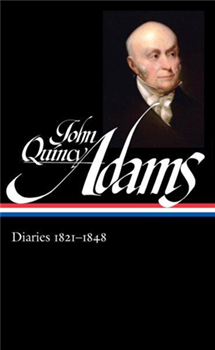Description
A landmark new selected edition of an American masterpiece: the incomparable self-portrait of a man and his times from the Revolution to the coming of the Civil War
The diary of John Quincy Adams is one of the most extraordinary works in American literature. Begun in 1779 at the age of twelve and kept more or less faithfully until his death almost 70 years later, and totaling some fifteen thousand closely-written manuscript pages, it is both an unrivaled record of historical events and personalities from the nation's founding to the antebellum era and a masterpiece of American self-portraiture, tracing the spiritual, literary, and scientific interests of an exceptionally lively mind. Now, for the 250th anniversary of Adams's birth, Library of America and historian David Waldstreicher present a two-volume reader's edition of diary selections based for the first time on the original manuscripts, restoring personal and revealing passages suppressed in earlier editions.
Volume 2 opens with Adams serving as Secretary of State, amid political maneuverings within and outside James Monroe's cabinet to become his successor, a process that culminates in Adams's election to the presidency by the House of Representatives after the deadlocked four-way contest of 1824. Even as Adams takes the oath of office, rivals Henry Clay, his Secretary of State, John C. Calhoun, his vice president, and an embittered Andrew Jackson, eye the election of 1828. The diary records in candid detail his frustration as his far-sighted agenda for national improvement founders on the rocks of internecine political factionalism, conflict that results in his becoming only the second president, with his father, to fail to secure reelection. After a short-lived retirement, Adams returns to public service as a Congressman from Massachusetts, and for the last seventeen years of his life he leads efforts to resist the extension of slavery and to end the notorious "gag rule" that stifles debate on the issue in Congress. In 1841 he further burnishes his reputation as a scourge of the Slave Power by successfully defending African mutineers of the slave ship Amistad before the Supreme Court. The diary achieves perhaps its greatest force in its prescient anticipation of the Civil War and Emancipation, an “object,” as Adams described it during the Missouri Crisis, “vast in its compass, awful in its prospects, sublime and beautiful in its issue.”
About the Author
John Quincy Adams (1767 -1848) was one of the most experienced and well-traveled American statesmen of his era. Before becoming the sixth president of the United States in 1825, he had served as a diplomat in the Netherlands, Prussia, Russia, and England, led the American commission that negotiated the Treaty of Ghent, ending the War of 1812, and served two terms as secretary of state. After his presidency, Adams was elected to the U.S. House of Representatives, serving for the remainder of his life, until his fatal collapse at his Congressional desk.
David Waldstreicher is Distinguished Professor of History at the Graduate Center, City University of New York, and the author of Slavery's Constitution: From Revolution to Ratification (2009); Runaway America: Benjamin Franklin, Slavery and the American Revolution (2004); and In the Midst of Perpetual Fetes: The Making of American Nationalism, 1776-1820 (1997). As editor, his books include A Companion to John Adams and John Quincy Adams (2013).
